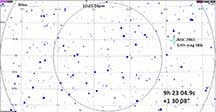


This high rank event has a predicted northern limit between Santa Cruz and Scotts Valley. Odds from home are 75% nominally. For Karl at the +1-sigma line, only 15% odds. It's decently placed in the east at 47 degrees altitude, w/o interferring stars. The target looks quite faint on the chart but the asteroid will be far brighter and look "out of place" in the eyepiece. At the centerline through Castroville it should last 5 seconds, but from Santa Cruz probably 2 seconds or less, making it rather difficult. The current default plan is for Kirk and to both try from our homes. Kirk is about 1 km south of me and deeper in the shadow than me.
 |
 |
 |
Nolthenius
I got a recording from home, using 8x setting. Kirk also got data from home, at 8x setting. Our analyses so far look like a miss, but given the shallow drop of only 0.22 mag = 22% light loss, it may have still been a short event for me or us, but not gotten above the noise level.
I think of the 4 levels that a light drop could satisfy. (0) there isn't even a hint of any light drop at all in the neighborhood of the predicted time of the occultation. (1) By eye it looks like a possible drop, but PyOTE fails to find it. (2) You mark a D and R revent and PyOTE does find the event, but it doesn't satisfy the red bar/black bar test. (3) It's obvious, and it satisfies the red bar/black bar test.
On that criteria, this event fits a (0), a miss. Any event that actually happened would likely be less than the 2 seconds interval predicted for my location and that I marked on the data curves.
|
The PyMovie screen, showing the sizes of the 5 apertures I chose. I renamed them after this screen capture. |
None of the default masks showed any hint of an occultation, and here I choose just mask=4px to plot, with vertical brown line at predicted occultation. |
I told PyMovie to track on the target star, then told it to set 5 more apertures. This is target-as-tracking aperture light curve, which was "snap-to" and dynamically masked. |
The entire light curve, with 2s event expected where. |
Zoomed in, with again a 2 second light curve with zero noise I drew in at the predicted event time. Looks like no event. |
 |
There is kinda sorta a dip in the middle, I marked it with D and R, but PyOTE could not find an event, even tried normalizing to a target, but had to use a high smoothing number to get minimal flatness, didn't help. Appsum looked worse. RN: I'd say the dip in the middle is actually a place of quieter noise, since there's an absence of both extra high and extra low points. It doesn't look like a dip to me. Looks like a miss or duration too short or too shallow a dip.
On the path map, Kirk was 1 km south of me and closer to the probable centerline. I'd be more likely to get a miss, but it looks like both of us got a miss, or any short event would have to be very very short to not show even the tiniest hint of a drop in any integrations at event time.
No attempt from Karl